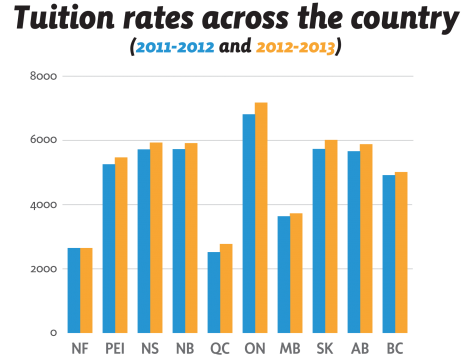According to a new report by Statistics Canada, tuition has increased by 5.4 per cent in Ontario, raising the average cost of education from $6,815 to $7,180.
A day earlier, the Canadian Centre for Policy Alternatives released a report that found the average cost to attend university rose 6.2 per cent annually between 1990 and 2011 nationwide.
These findings have renewed debate over the price of a post-secondary education in Canada, just as students return to classes for a new school year.
“Governments are continuing to shift the cost of public education onto the backs of students and their families,” said Adam Awad, national chairperson of the Canadian Federation of Students. “By increasing tuition fees in a time of economic uncertainty, provincial governments are further reducing access to education and skills training.”
The 5.4 per cent increase means that the cost of tuition is rapidly outpacing inflation. Between 1990 and 2011 inflation ran at an average of only 2.1 per cent.
“Tuition rates go up in keeping with costs,” insists Jonathan Scott, president of the University of Toronto Liberals.
But according to the Centre’s report, if tuition had increased on par with inflation, the national average would be $3,096. Instead, the current national average is $6,186.
Over the past 20 years, tuition fees have increased by 206.9 per cent, while inflation was a cumulative 70.1 per cent for the same period.
Expressions of frustration with rising costs have spread. Quebec has been rocked by student-led protests over a plan to increase fees. The protests drew hundreds of thousands into the streets, and may have contributed substantially to the ouster of Liberal premier Jean Charest in this month’s provincial election.
In Ontario, a 30 per cent tuition rebate introduced after the last election failed to placate some student leaders.
“The province definitely needs to invest more than a 30 per cent coupon,” said Katherine Ball, president of the Arts and Science Students’ Union.
“Thirty per cent was a promise to help middle and modest income students,” says Scott, who compared frustration with the rebate to “saying the cost of your Macbook went up, but you still have a 30 per cent off coupon.”
Sarah King, chairperson of the Ontario chapter of the Canadian Federation of Students has a different view. She says Ontario students are paying the highest tuition nationwide for the fourth year in a row.
“Per-student funding for colleges and universities in Ontario is the lowest in the country, resulting in the worst student-faculty ratios,” adds King.
On their website, the CFS-O raises concerns about professor-student ratios, class sizes and the transparency of consultations held over the summer.
The Canadian Centre for Policy Alternatives highlights further concerns, including significant financial burdens that remain in accessing education among low-income earners. The report finds that while more than half of students from the top quintile of wealthy families attend university, less than a third from the bottom quintile manage to do so. In addition, 34.8 per cent of 18 to 24 year-olds said they did not go on to higher education because of financial barriers.
“This government has done more than any government in our lifetime to increase scholarships and bursaries and improve OSAP,” counters Scott, describing recent reforms to OSAP designed to make it easier for students to pay off debt, as well as the targeted investments in specific institutions.
As students across the country hit the books again, the question on everybody’s mind is: are classes this year really worth $365 more than last year?


